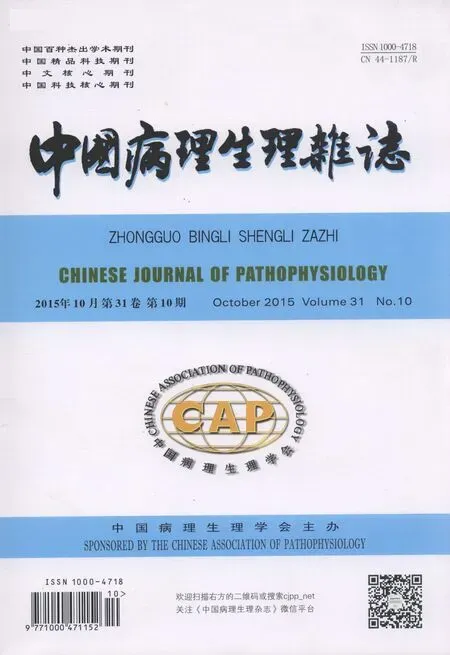调控USP8基因抑制神经炎症
朱丽红,赵佳仪,蓝 欣,袁 羽,陆大祥(暨南大学医学院,广东广州510632)
调控USP8基因抑制神经炎症
朱丽红△,赵佳仪,蓝欣,袁羽,陆大祥
(暨南大学医学院,广东广州510632)
目的:探讨调控泛素特异性修饰酶8(USP8)的表达对小胶质细胞活化的影响。方法:采用脂多糖(LPS)诱导BV2小鼠小胶质细胞为活化的细胞模型,分别应用分子生物学技术构建pGCMV/IRES/EGFP-USP8载体研究上调USP8基因和RNA干扰技术研究干扰USP8基因对LPS诱导BV2小胶质细胞一氧化氮(NO)和前列腺素E2(PGE2)的含量、一氧化氮合酶(iNOS)和环氧合酶2(COX-2)的表达以及核因子抑制蛋白(IκBα)降解的影响。结果:高表达USP 8可明显抑制LPS刺激BV2小胶质细胞NO和PGE2的释放,可明显减少LPS刺激BV2小胶质细胞iNOS和COX-2表达以及IκBα蛋白的降解。高表达USP8可减少炎症因子的释放。USP8 siRNA可明显增加LPS刺激BV2小胶质细胞NO和PGE2的释放,可明显增加LPS刺激BV2小胶质细胞iNOS和COX-2表达以及IκBα蛋白的降解。结论: USP8的高活性可调节促炎症细胞因子的释放,进而抑制小胶质细胞的激活,抑制神经炎症和减轻炎症反应。
Exogenous EETs or sEH inhibition offers inhibitory effects on obesity progression,which is associated with reduced adipocyte differentiation and adipogenesis,and increased energy expenditure.Furthermore,CYP epoxygenase gene delivery and sEH inhibition markedly decreased plasma cholesterol and triglyceride levels due to reduced lipid synthesis.CYP epoxygenase overexpression or sEH inhibition attenuated liver steatosis,which was associated with decreased inflammatory response and lipid synthesis.
High-fat diet (HFD) treatment as little as 3 d induced fatty liver,insulin resistance and adipose inflammation.n3 PUFAs and their metabolites eicosanoids mediate protective effects on several metabolic disorders.However,the functions of n3 PUFA metabolites are largely unknown.Early in the course of HFD feeding for 4 d,we found significant lipid accumulation in mouse liver which was reversed by an n3-enriched diet (3% w/w) with decreased lipogenesis and increased beta-oxidation-related gene expression.Next,LCMS/MS was used to determine the plasma eicosanoids profile.In those mice,the liver lipid accumulation was positively associated with hydroxyeicosapentaenoic acids (HEPEs) and epoxyeicosatetraenoic acids (EEQs) levels.However,HEPEs and EEQs treatment did not ameliorate palmitate-induced steatosis in primary hepatocyte,suggesting an exitence of an indirect effect.Indeed,n3 PUFA supplementation significantly improved HFD-induced macrophage infiltration in adipose tissue and decreased the proinflammatory cytokine levels in plasma.Furthermore,the expression of proinflammatory cytokines and the activation of JNK pathway induced by palmitate was suppressed by HEPEs and EEQs in macrophages.In conclusion,n3 PUFA supplementation ameliorates HFD-induced inflammatory effect in adipose tissue and consequently hepatic steatosis by increasing EEQs and HEPEs.
△Corresponding author AI Ding E-mail: edin2000cn@gmail.com; ZHU Yi E-mail: zhuyi@tijmu.edu.cn
▲These authors contribute equally to this work
The current study aims to explore the signaling pathway involved in hyperhomocysteinemia (HHcy) -induced hepatic steatosis.First,we performed a meta-analysis involving 2 057 subjects and revealed that plasma homocysteine (Hcy) levels was associated with an increased risk of nonalcoholic fatty liver disease (P<0. 05).Next,C57BL/6 mice were fed a high-methionine diet (HMD) (2%,wt/wt) for 8 weeks to establish a HHcy mouse model with hepatic steatosis and elevated CD36 expression in the liver.The increased CD36 expression was associated with activation of aryl hydrocarbon receptor (AHR).Furthermore,mass spectrometry analysis showed that hepatic content of lipoxin 4A,a well-known ligand of AHR,was significantly elevated in HHcy mice.In primary hepatocytes,the Hcy-induced CD36 expression and subsequent lipid uptake were significantly attenuated by AHR siRNA.Transient transfection assays showed that the activity of AHR response element was dramatically increased in a ligand-dependent manner by Hcy.In addition,Hcy treatment promoted the bingding of AHR to CD36 promoter.Finally,AHR antagonist CH223191 reversed lipid accumulation caused by HHcy via inhibiting AhR-CD36 pathway.In conclusion,HHcy activates AHR-CD36 pathway by increasing hepatic lipoxin 4A content,which results in hepatic steatosis.
△Corresponding author AI Ding E-mail: edin2000cn@gmail.com; ZHU Yi E-mail: zhuyi@tijmu.edu.cn
Hydroxysteroid sulfotransferase 2B1 (SULT2B1) sulfates cholesterol and oxysterols.Hepatic oval cells (HOCs),thought to be progenitor cells,can be triggered in chemical-injured livers.The present study focuses on the role of SULT2B1 in hepatic oval cell proliferation after liver injury.Wild-type (WT) and SULT2B1-/-mice were fed with a 3,5-diethoxycarbonyl-1,4-dihydrocollidine (DDC) -containing diet.Our experiments revealed that the expression of SULT2B1 increased dramatically in chemical-induced liver injury model,which mainly occurred in HOCs.In vivo,enhanced expression of SULT2B1 shows positive correlation with the number of HOCs during DDC-induced liver injury and negative correlation with liver function.In vitro,HOCs derived from SULT2B1-/-mice showed lower proliferation capability than those from WT mice.SULT2B1 overexpression/knockdown by Ad-SULT2B1/SULT2B1-siRNA could promoted/inhibited WB-F344 cell growth.The upregulated SULT2B1 might promote hepatic oval cell proliferation and aggravate liver injury,which might be mediated by the inactivation of LXR.Moreover,we demonstrated that SULT2B1 might further activate IL-6-gp130-STAT3 signaling pathway,eventually promote hepatic oval cell proliferation and aggravate liver injury.In conclusion,our data indicate that the upregulated SULT2B1 plays a harmful role during chemical-induced liver injuries by promoting hepatic oval cell proliferation.
△Corresponding author Fax: 86-21-54237623; YIN Lian-hua E-mail: lhyin@shmu.edu.cn; LI Xiao-bo E-mail: xbli@fudan.edu.cn
Role of cytochrome P450 epoxygenase and EETs in regulating metabolism-related diseases
WANG Dao-wen
(Department of Internal Medicine and Gene Therapy Center,Tongji Medical College of Huazhong University of Science and Tochnology,Wuhan 430030,China.Tel: 027-83663280; E-mail: dwwang@tjh.tjmu.edu.cn)
Hydroxyeicosapentaenoic acids and epoxyeicosatetraenoic acids derived from n3 polyunsaturated fatty acid attenuate early occurrence of nonalcoholic fatty liver disease: targeted metabolomics-based research
WANG Chun-jiong▲,LIU Wen-li▲,YAO Liu,ZHANG Xu,AI Ding△,ZHU Yi△
(Department of Physiology and Pathophysiology,Tianjin Medical University,Tianjin 300070,China)
Hyperhomocysteinemia activates aryl hydrocarbon receptor-CD36 pathway to promote hepatic steatosis in mice liver
YAO Liu,WANG Chun-jiong,LIU Wen-li,ZHANG Xue-jiao,AI Ding△,ZHU Yi△
(Collaborative Innovation Center of Tianjin for Medical Epigenetics and Department of Physiology and Pathophysiology,Tianjin Medical University,Tianjin 300070,China)
SULT2B1 promotes hepatic oval cell proliferation by suppressing LXR activation inDDC-induced mouse liver injury
WANG Zheng-yang1,YANG Xiao-ming2,CHEN Liang1,ZHI Xiu-ling1,LU Han-yu1,NING Yan-xia1,Pohsheng Yeong3,4,CHEN Si-feng1,YIN Lian-hua1△,LI Xiao-bo1△
(1Department of Physiology and Pathophysiology,School of Basic Medical Sciences,Fudan University,Shanghai 200032,China;
2Ningxia Medical University,Yinchuan 750004,China;3Department of Pathology,Singapore General Hospital,Singapore;
4Singapore Immunology Network,Agency for Science,Technology and Research,Biopolis,Singapore 138648,Singapore)
△E-mail: lhzhu@jnu.edu.cn

